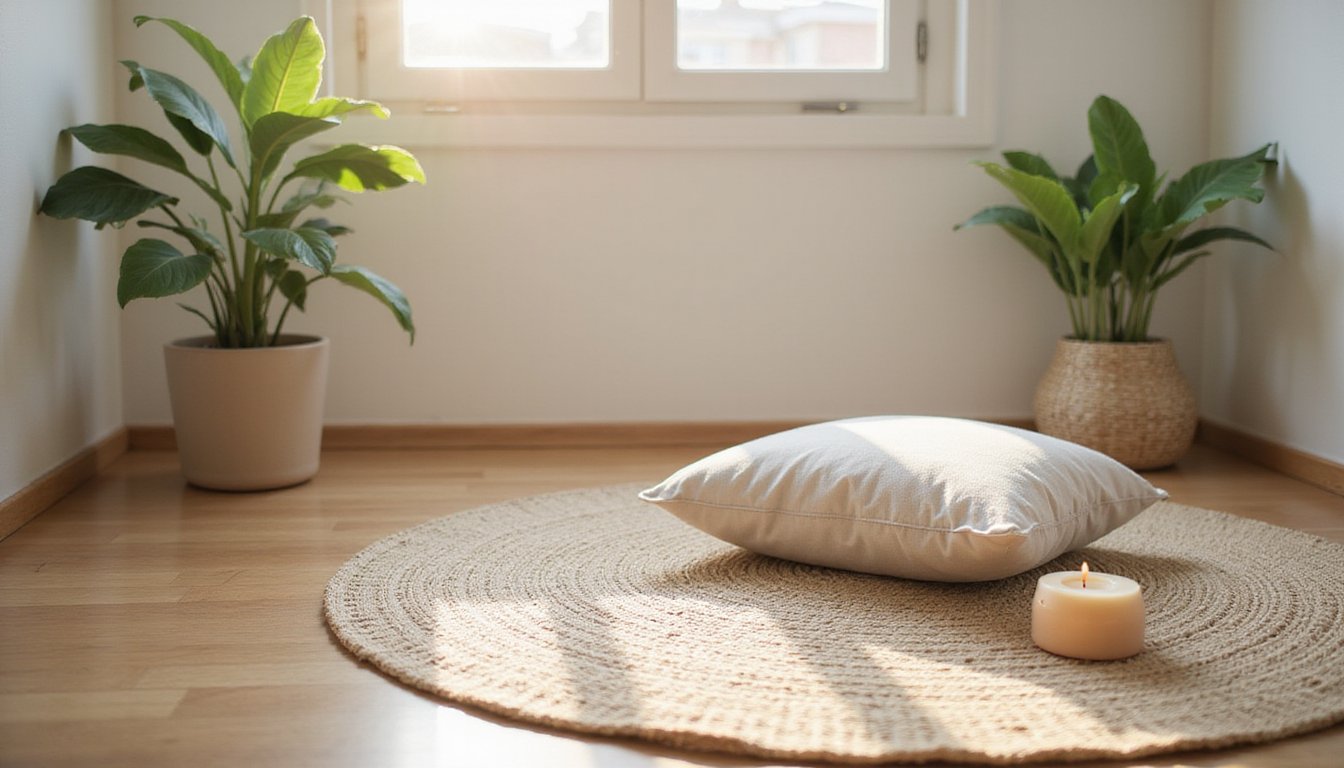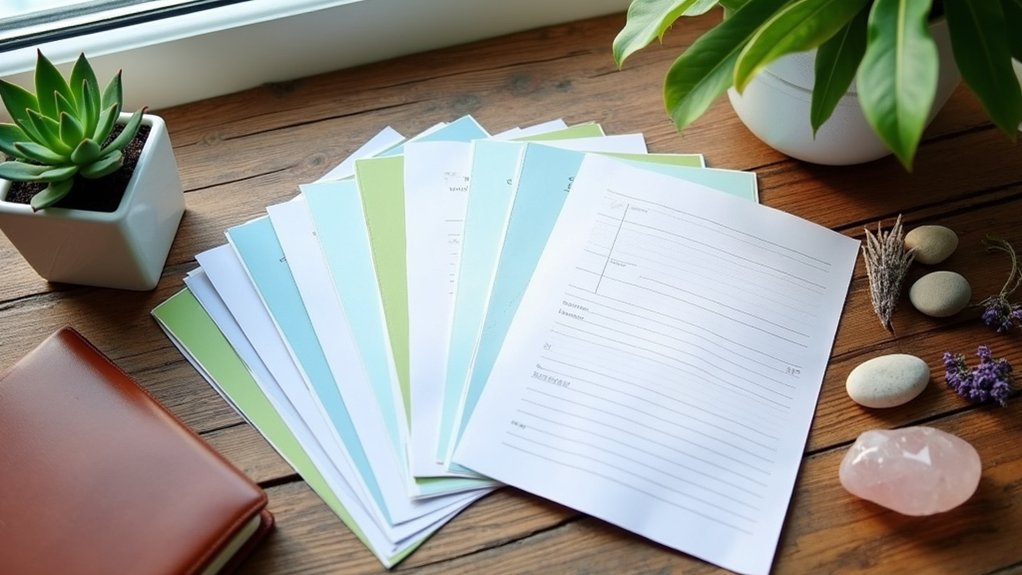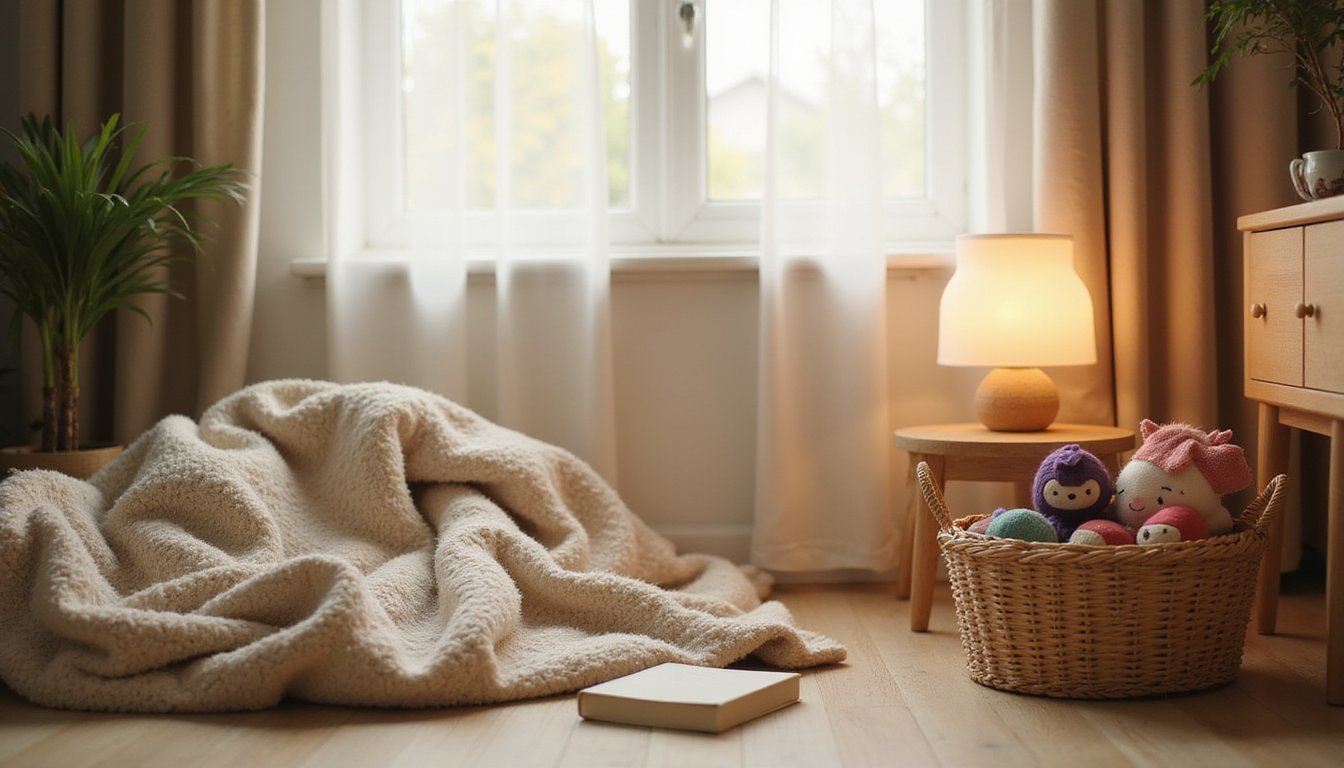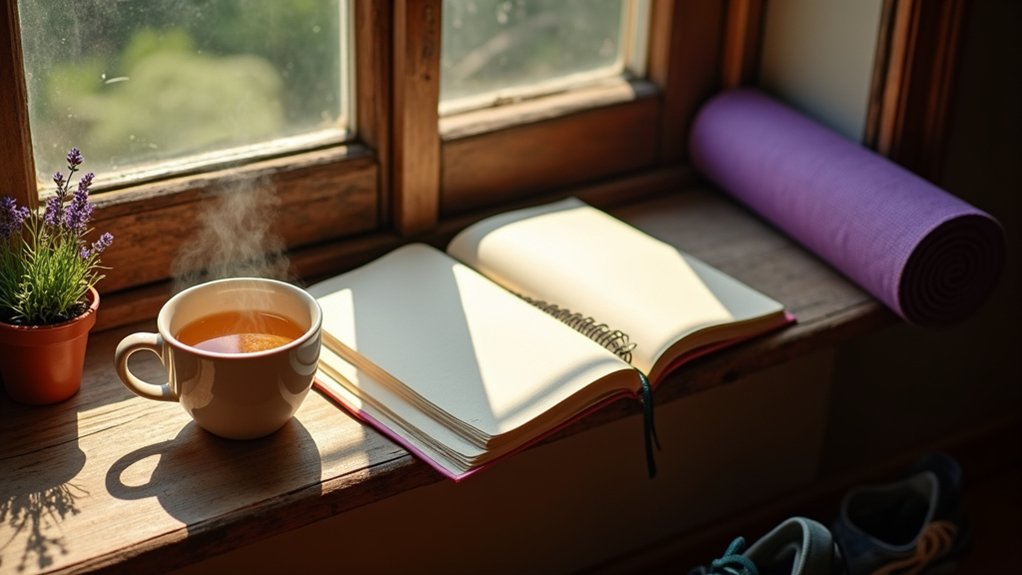Establish reliable daily routines to anchor your mental well-being, starting with consistent sleep and meal times. You’ll find significant relief from anxiety through 30 minutes of daily movement, whether it’s walking, yoga, or cycling. Incorporate quick mindful breathing exercises between activities to activate your body’s natural relaxation response. When combined with gentle self-talk and brief mindfulness resets, these evidence-based habits create a powerful foundation for managing stress. Let’s explore how to weave these practices seamlessly into your day.
Building a Foundation With Reliable Daily Routines

The foundation of managing stress and anxiety begins with establishing reliable daily routines – a strategy backed by compelling research. When you create consistent patterns in your daily activities, you’re building powerful protection against persistent anxiety and depression, reducing your risk by over 13%. These routines act as social zeitgebers that help maintain your internal biological rhythms and mental well-being. Making time to unwind through meditation can significantly reduce daily tension levels.
The key lies in balancing structure with flexible adaptation across your core activities. By maintaining regular times for sleeping, eating, socializing, and leisure, you’ll strengthen your self-efficacy, your belief in handling life’s challenges. This enhanced sense of control directly improves your ability to cope with stress. Research shows that people who maintain structured routines experience better psychological adjustment during difficult times, while still allowing room for necessary adaptations. Studies indicate that spending more leisure time can help offset the negative effects of daily stressors on emotional well-being. Your daily routines serve as anchors, providing stability when life feels overwhelming.
Moving Your Body to Lift Your Mood
While managing stress and anxiety requires multiple strategies, physical movement stands out as one of the most powerful tools backed by neuroscience. When you exercise, your brain releases mood-enhancing chemicals like serotonin, dopamine, and endorphins, creating natural relief from stress and anxiety. Mindfulness-based exercises like yoga and tai chi have shown remarkable benefits for mental wellness.
Research shows that brain-derived neurotrophic factor increases during exercise, helping your brain adapt and rebuild neural connections. You don’t need complex manageable workout routines to experience these holistic exercise benefits. Just 30 minutes of walking, running, or cycling can reduce your depression risk by 26% and provide immediate anxiety relief. Even everyday household chores can contribute to improved mental well-being. By combining different activities, like aerobic exercise with strength training or yoga, you’ll maximize both physical and emotional outcomes. The key is consistency: aim for 150 minutes of moderate activity weekly, spread across several days. Choose activities you enjoy, as this makes it easier to maintain the habit and secure lasting mental health benefits.
Creating Moments of Peace Through Mindful Practices

When stress and anxiety start to overwhelm you, taking mindful moments throughout your day can create powerful shifts in your emotional state. You’ll find relief through proven techniques like focused breathing exercises, body scan meditations, and quick mindfulness check-ins that help anchor you to the present moment. Healthcare research demonstrates that mindfulness-based interventions can effectively reduce anxiety, depression, and stress levels among professionals. The practice of mindfulness has seen significant growth, with yoga participation increasing from 6% to 11% between 2002 and 2012. By incorporating gentle self-talk and brief mindfulness resets into your daily routine, you’re building sustainable habits that research shows can substantially/considerably/markedly reduce psychological distress while enhancing your overall well-being. Studies indicate that practicing these mindful habits in a digital learning environment can make it easier to access and maintain a consistent mindfulness practice from anywhere.
Breathe Through Daily Stress
Managing daily stress becomes remarkably easier through mindful breathing practices, as demonstrated by extensive research showing profound physiological and psychological benefits. You’ll find that taking intentional breathing breaks throughout your day can considerably reduce anxiety and restore calm to both mind and body. These self-administered mindfulness exercises offer a convenient and accessible way to reduce stress without requiring formal training or programs.
Studies consistently demonstrate the power of mindful breathing to lower stress levels and activate your body’s natural relaxation response. Here’s what you can expect when practicing mindful breathing:
- Your heart rate and blood pressure decrease as your parasympathetic nervous system activates
- Each focused breath helps in exhaling anxiety, with studies showing substantial reductions in psychological distress
- Brief daily breathing exercises prove more effective than other stress management techniques, even as a standalone practice
Incorporate these evidence-based breathing moments into your routine to experience lasting stress relief and enhanced well-being.
Quick Mindfulness Reset Techniques
Despite life’s constant demands, you can create powerful moments of peace through quick mindfulness reset techniques that take just minutes to implement. Try the sensory spotlight technique by focusing on three specific details in your environment for 60 seconds, or practice mindful walking by paying attention to each step for just one minute. Executive attention improvements have been shown after just 10 minutes of mindfulness practice, even in beginners.
Create intentional focus moments between activities by pausing for 30 seconds to acknowledge your shifts. When anxious thoughts arise, visualize them as passing clouds or waves for a minute, this simple practice helps reduce reactivity. These techniques are especially effective for those with ADHD brain tendencies, as they work with rather than against natural attention patterns. Taking a non-judgmental approach while observing your thoughts allows you to remain curious rather than critical of your experiences. Incorporate brief breath exercises while using everyday objects as mindfulness triggers, like your water bottle or phone. These evidence-based techniques can interrupt stress cycles, enhance your awareness, and provide immediate calm without requiring lengthy meditation sessions.
Soothing Self-Talk Practices
Building on mindfulness techniques, the power of our inner dialogue shapes our emotional landscape and stress response. Through guided self-reflection and self-affirming dialogues, you can transform negative thought patterns into supportive self-talk that reduces anxiety and builds resilience. Trait mindfulness and self-compassionate internal dialogue work together to promote greater psychological well-being and reduced stress levels.
Research shows that the quality of your self-talk matters more than frequency, with mindful, compassionate dialogue creating lasting psychological benefits. Interestingly, studies suggest that self-critical dialogue can improve cognitive performance in certain situations. Developing a more optimistic mindset can lead to better physical health and increased longevity. You’ll find greater emotional balance by:
- Using short, gentle self-statements during stressful moments
- Acknowledging thoughts without judgment while maintaining a kind inner voice
- Practicing mindful pauses to reframe negative self-talk into supportive messages
When you consistently engage in positive self-talk, you’re not just temporarily relieving stress; you’re rewiring neural pathways for enhanced emotional well-being and sustainable mental health.
Mastering Sleep for Mental Well-being
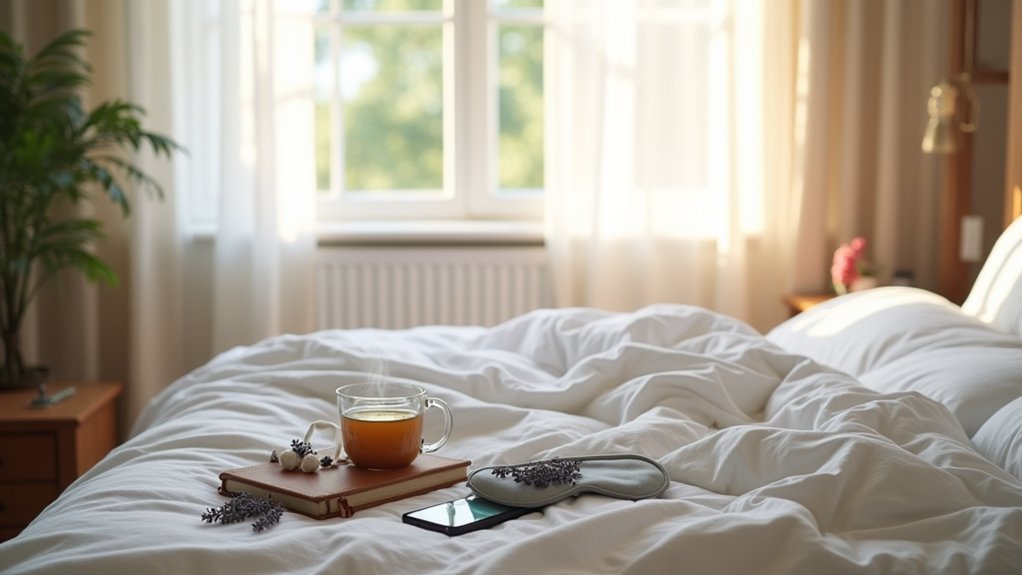
When it comes to mental well-being, quality sleep serves as a cornerstone for emotional resilience and stress management. Poor sleep can double your risk of mood changes and drastically impact your ability to handle daily stressors. By implementing sleep hygiene techniques and natural sleep aids, you’ll boost your mental health and reduce anxiety symptoms.
| Sleep Impact | Mental Health Benefits |
|---|---|
| 7+ Hours/Night | 53% reduction in anxiety |
| Regular Schedule | Better emotion regulation |
| Quality Rest | Enhanced stress resilience |
You’re not alone if you’re struggling with sleep; nearly one-third of people face similar challenges. The good news is that improving your sleep quality can lead to substantial improvements in your mental well-being, with studies showing reduced depression, anxiety, and rumination. Your brain needs this nightly reset to process emotions and maintain psychological balance.
Nurturing Social Bonds for Emotional Support
Just as quality sleep restores our mental balance, meaningful social connections serve as powerful anchors for emotional well-being. Research shows you’re 3.6 times less likely to experience stress when you maintain strong social bonds. By actively participating in group bonding experiences and community-based support programs, you’ll build a robust network that buffers against life’s challenges.
To strengthen your social connections and improve your mental health:
- Schedule regular check-ins with friends and family, whether virtual or in-person
- Join community groups or classes that align with your interests
- Seek out diverse forms of support – emotional, practical, and informational
Designing a Stress-Free Living Space
Creating a living space that promotes tranquility can markedly reduce your daily stress levels and anxiety. By integrating natural lighting and selecting multi-purpose furniture, you’ll establish an environment that supports emotional well-being and mental clarity.
| Design Element | Stress-Reducing Benefits |
|---|---|
| Cool Colors | Lowers blood pressure and heart rate |
| Natural Elements | Improves mood and reduces mental fatigue |
| Decluttered Space | Decreases cortisol levels and anxiety |
Your living space should incorporate sound-absorbing materials and create dedicated quiet zones for retreat. Choose curved furniture arrangements over angular layouts, and include indoor plants to improve air quality while reducing stress. Remember to establish separate areas for relaxation and focused activities, using light-diffusing materials to minimize harsh shadows. Consider installing warm, soft lighting for evening hours to support your natural wind-down routine.
Making Self-Care a Non-Negotiable Priority
When you’re feeling overwhelmed, starting with small, manageable self-care actions like proper hydration or a 10-minute meditation can create momentum for lasting change, as research shows 67% of people have maintained such habits since adopting them during the pandemic. You’ll benefit from blocking off protected time in your schedule for self-care activities, especially since data indicates that consistency, not complexity, is the key to preventing burnout. Creating a dedicated space for your wellness routines, whether it’s a quiet corner for reading or an area for exercise, can help you maintain these practices even when life gets chaotic.
Small Steps Matter Most
Taking small steps toward self-care yields remarkable benefits, as research shows even 5-10 minutes of daily practice can substantially improve mood and stress management. When you create customized routines that fit your lifestyle, you’re more likely to maintain them long-term. Simple schedule refreshers throughout your day can serve as effective mini-recharges, helping you build sustainable habits for emotional resilience.
Consider incorporating these science-backed activities into your daily routine:
- Take short walks in nature to clear your mind and reduce stress
- Practice mindful breathing exercises during work breaks
- Read for pleasure, even if just for a few minutes
Starting with manageable changes prevents overwhelm and increases your likelihood of success. Remember, these small investments in yourself create new neural pathways that strengthen your ability to cope with daily challenges.
Protected Time For You
Research shows that setting aside dedicated time for self-care isn’t just a luxury; it’s a critical investment in your mental and physical well-being. Studies reveal that people who maintain protected time boundaries for self-care experience improved life satisfaction, mental clarity, and stronger relationships.
You don’t need expensive spa treatments to practice effective self-care. Simple at-home activities like early bedtimes, quiet reading, or mindful bathing can deliver significant benefits. The key is making this time non-negotiable by scheduling it as you would any important appointment. To reduce self-care guilt, remember that 73% of Americans wish they had more time for self-care; you’re not alone in needing this essential maintenance. Consider starting with just 60 minutes weekly, as research shows even this modest commitment can lead to meaningful improvements in stress levels and overall resilience.
Create Your Sacred Space
One powerful way to protect your self-care time involves creating a dedicated sacred space within your home. Think of it as your personal altar design, a private sanctuary where you can escape daily stressors and reconnect with yourself. This space becomes your refuge for intention-setting rituals and mindfulness practices that ground you during challenging times.
To create an effective sacred space:
- Choose a quiet, decluttered area with natural light and minimal distractions
- Incorporate meaningful elements like calming decor, plants, or spiritual objects
- Add sensory components such as soft textiles, candles, or gentle aromatherapy
When you consistently use this space for meditation, reflection, or simple breathing exercises, you’ll notice improved emotional balance and mental clarity. Your sacred space serves as a physical reminder to prioritize your well-being and maintain healthy boundaries.
Frequently Asked Questions
How Long Does It Take for New Stress-Management Habits to Become Automatic?
You’ll need about 2-8 months of sustained focus for your stress-management habits to become automatic, with research showing an average of 66 days. Don’t get discouraged if it’s taking longer; it’s a gradual progression that varies by person and habit complexity. You’re more likely to succeed if you link your new habits to existing routines, like doing deep breathing after your morning coffee. Consistency matters more than perfection.
What Should I Do When Established Routines Get Disrupted by Unexpected Events?
When routines get disrupted, acknowledge your emotional response first; it’s natural to feel unsettled. Focus on adjusting schedules gradually while maintaining flexibility in your core activities. You’ll want to prioritize essential tasks and build in buffer time for unexpected changes. Try practicing stress-management techniques like deep breathing or brief walks, and remember that it’s okay to temporarily modify your usual routine until you can restore stability.
How Can I Maintain Healthy Habits While Traveling or During Major Transitions?
When traveling or facing changes, prioritize staying flexible with schedules while maintaining consistent self-care. Pack healthy snacks, stay hydrated, and plan brief movement breaks during transit. You’ll benefit from setting a regular sleep schedule and keeping up with mindfulness practices. Make use of hotel amenities for exercise, and don’t forget to schedule dedicated time for self-care activities. Even small, consistent efforts can help you maintain wellness during disruptions.
Which Stress-Reduction Techniques Work Fastest During Acute Anxiety or Panic Attacks?
When you’re experiencing acute anxiety or panic, deep breathing exercises like box breathing (4 seconds in, hold, out, hold) work almost immediately to calm your nervous system. You’ll also find quick relief through progressive muscle relaxation, systematically tensing and releasing muscle groups. Try grounding yourself by putting cold water on your wrists or face, and practice the 5-4-3-2-1 technique, focusing on your senses to break the panic cycle.
How Do I Balance Multiple Priorities Without Sacrificing Mental Health Practices?
Start by developing strong time management skills through calendar blocking and task batching. You’ll want to schedule self-care activities first, treating them as non-negotiable appointments. Break larger tasks into smaller, manageable chunks while prioritizing essential tasks that align with your core values and goals. Don’t forget to build in buffer time between commitments and maintain firm boundaries around your mental health practices; they’re just as important as work deadlines.








